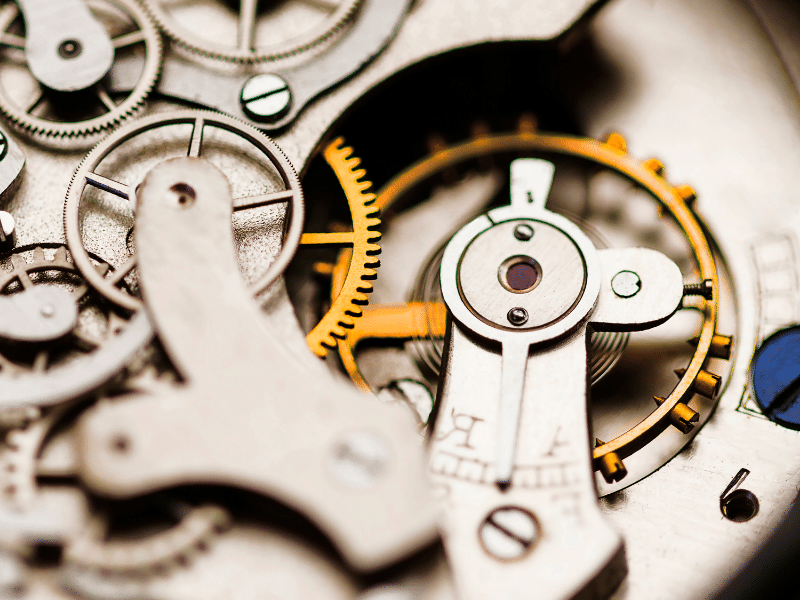Luxury watch terminology explained
Owning a luxury watch is an ambition of many people. Often the buyer has saved up for a while and is looking to purchase a watch that is both beautiful and durable. However, it can be overwhelming trying to navigate your way through the jargon and technical terminology used by diehard watch fans and experts.
Think of this as your guide to understanding some of the most important luxury watch terminology used.
A
Automatic: This is a mechanical watch that is wound by the motion of the wearer’s wrist, rather than by twisting the crown. When the wearer’s wrist moves, it causes a counterweight called a rotor to power the mainspring, which turns the watch’s gears.
B
Balance Wheel: A weighted wheel that oscillates at a constant rate. It moves the watch’s gears, allowing the hands to move forward.
Balance Spring: This is a delicate spring attached to the balance wheel that regulates the rate at which a balance wheel oscillates.
Bezel: A bezel is a metal ring that surrounds the watch crystal. Often, bezels rotate on watches (typically on dive watches) and contain a scale for time or other measurements. They can differ on different watches.
C
Calibre: This refers to movement, most often used when a manufacturer is denoting a specific model name for a movement.
Chronometer: A watch that has been independently tested by the Official Swiss Chronometer Testing Institute (COSC) in Switzerland (or any other official governing body in other countries).
Crown: This is the small knob on the side of the watch case that can be used to adjust the time, date and wind the watch to keep it running if it isn’t automatic.
D
Deployant Clasp: A type of watch strap buckle that closes by folding in on itself, then clasping. This type of strap makes it easier to take the watch on and off and keeps the leather from getting worn or stretched out.
Dive Watch: While a dive watch is a water-resistant watch, not all water-resistant watches are dive watches. True dive watches have to meet a specific standard for diving, which requires the watch to be water-resistant to at least 200 metres, feature a unidirectional rotating bezel and some form of illumination.
E
Escapement: This is an internal component in a mechanical watch that transfers the power from a wound-up watch into the movement of the watch’s seconds hand. It does this by driving the balance wheel at a steady rate.
F
Frequency: This refers to the speed at which a watch ticks, measured in either vibrations per hour or hertz. A watch’s frequency is controlled by the oscillations of its balance wheel.
G
Gasket: A rubber, neoprene or plastic ring used to seal the gaps between the case and the case back, crystal and crown to prevent water or dust from entering the case and damaging the movement inside.
Gear Train: The system of gears that transfer power from the mainspring to the escapement.
GMT: Though it stands for Greenwich Mean Time, a watch referred to as a GMT has the ability to track two time zones at once. This was originally developed by Rolex for pilots in the 50s, and they are particularly useful for any frequent flyer.
H
Hacking Seconds: Also referred to as “stop seconds,” this function will stop the seconds hand when the crown is pulled out. This makes it easier to synchronise a watch with another timepiece.
Hand-wound: Referring to a mechanical watch that doesn’t automatically wind.
I
Indices: The markings on the dial of a watch used to represent the hours in place of numerals. Luxury watches have the indices attached to the dial rather than printed on.
L
Lugs: This is the protruding pieces of metal at the top and bottom of a watch case where the strap is attached. The two ends of the lug hold a spring bar, which holds the strap in place.
M
Magnetism: Metal components inside a watch can often be magnetised when introduced to magnetic fields, thus causing a serious loss of accuracy. This happens mostly when the balance spring becomes magnetised and sticks to itself, causing the watch to run faster than usual. Fortunately, this problem can be fixed quickly and easily at a watchmaker.
Mainplate: The base on which all the parts of a mechanical watch movement are mounted.
P
Power Reserve: This is the length of time that a mechanical watch can run once it’s fully wound. How long the power reserve can run for depends on the watch.
Q
Quartz: A quartz watch is a battery-powered watch. Quartz watches are considerably more accurate, more reliable and cheaper than their mechanical counterparts.
R
Retrograde: An indicator on a watch dial which forms a segment of a circle, rather than a full circle. When the indicator goes through a full cycle, it resets back to the zero position by moving backward. This is often used to indicate hours, minutes or dates.
S
Skeleton: A skeleton watch shows off the inner workings of the watch, but does so through a transparent or partially cut-out dial so that the movement can be viewed from the front of the watch.
Small Seconds: A small sub-dial separate from the main hour and minute function that displays the seconds.
T
Tourbillon: This is a type of escapement housed in a rotating cage that is meant to counter the negative effects gravity has on a movement. While originally intended for pocket watches, they’ve moved to wristwatches as a way to showcase the height of a manufacturer's watchmaking abilities.
W
Winder: A box or case that gently rotates an automatic watch to keep the mainspring fully wound when it isn’t being worn.
World timer: A watch with a dial that can be adjusted to show the time in 24 different time zones represented by 24 major cities across the globe.
Summary
Here at Cuttings Jewellers and Pawnbrokers, we have a range of stunning luxury watches for both him and her. You can shop here if you are interested.
If you wish to enquire about a watch, or to get advice, you can find out contact information here where you can speak to one of our experts who can help you.




